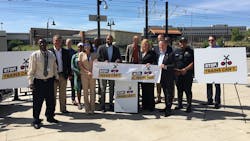RTD of Denver brings attention, education to local rail safety efforts
Officials from the Regional Transportation District (RTD) of Denver, Colorado Department of Transportation (CDOT), U.S. Department of Transportation and city and county of Denver reminded the public about the need for safety around railroad crossings during the local launch of a national rail grade crossing safety campaign: “Stop. Trains Can’t.”
In 2018, 270 people were killed at railroad crossings – a 10-year high – according to data from the Federal Railroad Administration. Of those deaths, 99 occurred after the driver drove past a lowered crossing gate arm. Between 2014 and 2018, 1,538 drivers were struck, accounting for 14 percent of all train collisions. These preventable crashes were caused by risky driving and poor decision-making.
“As we continue to expand our system with the opening of six new projects in the past three years, our commitment to safety grows along with our footprint and impact across the metro area,” said RTD General Manager and CEO Dave Genova. “With nearly 100 miles of rail track throughout the region, most of the public interacts somehow with our service. We ask that everyone, from RTD staff to our riders to the general public, be our partners in safety and remain alert when around our vehicles and tracks.”
By law, trains always have the right of way, and avoiding a train collision is the responsibility of the driver, pedestrian, bicyclist or motorcyclist. A train cannot swerve, stop quickly or change directions to avert a collision. A train traveling at 55 mph requires a mile to stop – the length of more than 17 football fields – after applying the emergency brakes.
There are 130,000 public railroad crossings in the United States. About 54 percent are “active” crossings, with warning devices such as gates, bells or flashing lights to alert drivers of an approaching train. The remaining 46 percent are “passive,” meaning only signs and markings are present. Approximately 60 percent of all collisions at railroad crossings occur at active crossings.
Safety is RTD’s core value, and the transit agency encourages its employees to practice constant awareness and improvement in their work to further reinforce community safety. RTD also relies on partnership with the public to practice safety around our system.
Follow these tips to stay safe at railroad crossings:
- When approaching a railroad crossing, slow down, look and listen for a train on the tracks, especially at passive crossings.
- Look carefully in both directions before crossing a rail track, even during the day. Sixty-seven percent of railroad crossing collisions occur in clear weather conditions.
- Do not rely on past experience to guess when a train is coming. Trains can travel from either direction at any time.
- Never race a train. It is easy to misjudge a train’s speed and distance from a crossing.
- Before entering a railroad crossing, check that there is enough room on the other side of the tracks for your vehicle to cross completely and safely. Be aware that you may need to cross multiple sets of tracks at some railroad crossings.
- Never stop on railroad tracks. Keep moving once you have entered the crossing. To avoid a vehicle stalling, never shift gears on the tracks.
- If your vehicle stalls on a railroad track, quickly move away from the track and your vehicle at a 45-degree angle. Call the phone number on the Emergency Notification System sign or, if the sign is not visible to you, dial 911 for help.
More information about “Stop. Trains Can’t.” is at www.transportation.gov/stop-trains-cant.
